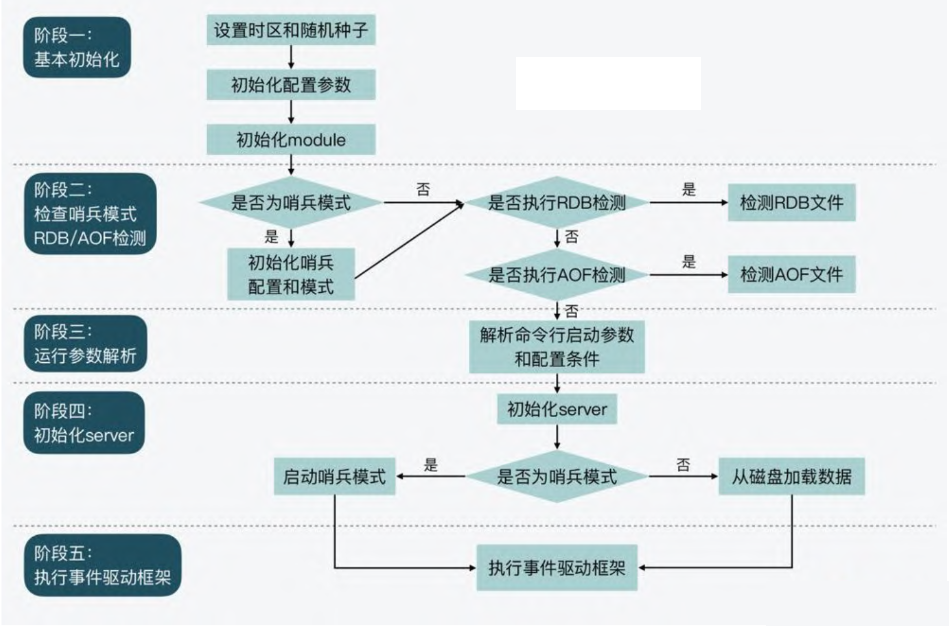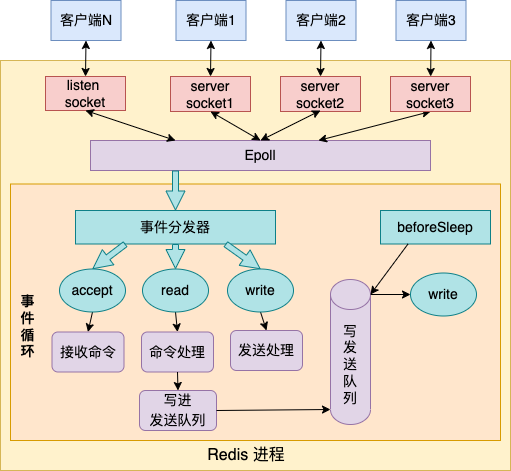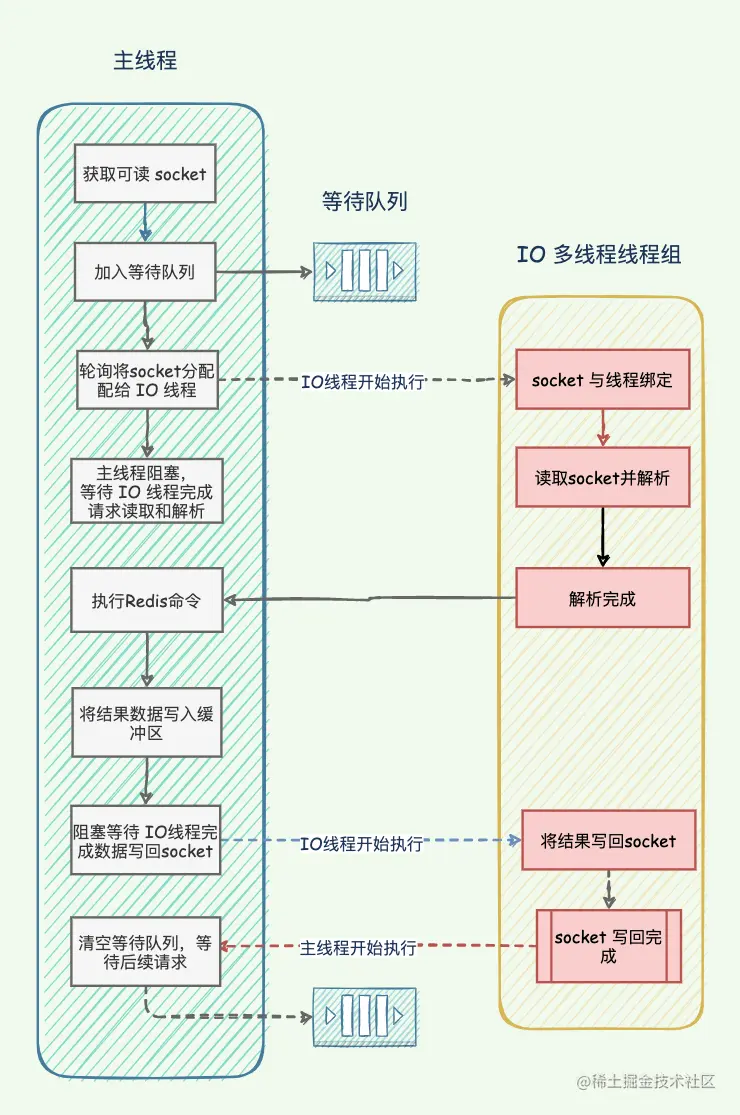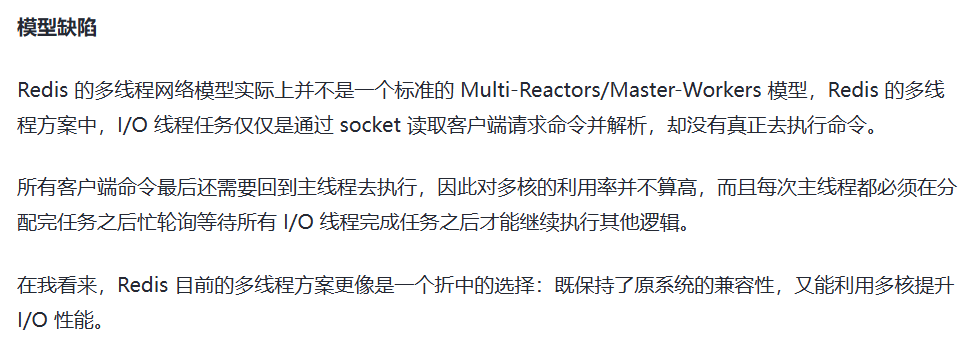核心源码解读 server.c 中是 redis 服务启动的入口,main
函数就在该文件中,主要完成下面几件事:
基本初始化
检查哨兵模式,并检查是否要执行 RDB 检测或 AOF 检测
运行参数解析
初始化 server
执行事件驱动框架
image20250123142642703.png
initServer initServer 函数:创建 eventLoop 和 创建 Redis 数据库并初始化
1 2 3 4 5 6 7 8 9 10 11 12 13 14 15 16 17 18 19 20 21 22 23 24 25 void initServer (void ) {int j;sizeof (redisDb)*server.dbnum); for (j = 0 ; j < server.dbnum; j++) { 0 ;0 ;void (*)(void *))sdsfree);
initListeners initListeners
函数:用于设置通信协议的监听器并确保系统能够正确接受客户端请求
1 2 3 4 5 6 7 8 9 10 11 12 13 14 15 16 17 18 19 20 21 22 23 24 25 26 27 28 29 30 31 void initListeners (void ) {int listen_fds = 0 ;for (int j = 0 ; j < CONN_TYPE_MAX; j++) {static int anetListen (char *err, int s, struct sockaddr *sa, socklen_t len, int backlog, mode_t perm) {if (bind(s,sa,len) == -1 ) {"bind: %s" , strerror(errno));return ANET_ERR;if (sa->sa_family == AF_LOCAL && perm)struct sockaddr_un *) sa)->sun_path, perm);if (listen(s, backlog) == -1 ) {"listen: %s" , strerror(errno));return ANET_ERR;return ANET_OK;
connAcceptHandler 函数:这个函数就是前面设置的回调函数
1 2 3 4 5 6 7 8 9 10 11 12 13 14 15 16 17 18 19 20 21 22 23 24 25 26 27 28 29 30 31 32 33 34 35 36 37 static inline aeFileProc *connAcceptHandler (ConnectionType *ct) {if (ct)return ct->accept_handler; return NULL ;static void connSocketAcceptHandler (aeEventLoop *el, int fd, void *privdata, int mask) {int cport, cfd; int max = server.max_new_conns_per_cycle;char cip[NET_IP_STR_LEN];while (max--) {sizeof (cip), &cport);NULL ), 0 , cip);static int anetGenericAccept (char *err, int s, struct sockaddr *sa, socklen_t *len) {int fd;return fd;void acceptCommonHandler (connection *conn, int flags, char *ip) {
截止到目前,我们已经创建一个事件循环对象,尽管这个事件循环还没有正式启动。接着,开始监听客户端的连接,如果有连接过来就会触发
connAcceptHandler 回调,这个回调函数会 accept
得到一个用于后续通信的连接。
我们有看到 创建一个客户端对象,并设置回调
readQueryFromClient,这是一个读的回调函数,那写的回调函数呢?
readQueryFromClient 在读取到客户端命令后,进行解析,解析完成就会调用
processInputBuffer --> processCommandAndResetClient -->
processCommand -->
addReply,把要回复的数据写入到客户端的缓冲区(注意,这个时候还没有设置写回调)。
前面我们注册过一个回调函数 beforeSleep,也就是 Redis
事件驱动框架每次循环进入事件处理函数前,也就是在框架主函数 aeMain 中调用
aeProcessEvents,来处理监听到的已触发事件或是到时的时间事件之前都会调用它。这其中就包括了调用
handleClientsWithPendingWrites 函数,它会将Redis
sever客户端缓冲区中的数据写回客户端。
1 2 3 4 5 6 7 8 9 10 11 12 13 14 15 16 17 18 19 20 21 int handleClientsWithPendingWrites (void ) {int processed = listLength(server.clients_pending_write);while ((ln = listNext(&li))) {if (writeToClient(c,0 ) == C_ERR) continue ;if (clientHasPendingReplies(c)) {return processed;
aeMain 1 2 3 4 5 6 7 8 void aeMain (aeEventLoop *eventLoop) {0 ;while (!eventLoop->stop) {
1 2 3 4 5 6 7 8 9 10 11 12 13 14 15 16 17 18 19 20 21 22 int aeProcessEvents (aeEventLoop *eventLoop, int flags) int processed = 0 , numevents;if (eventLoop->maxfd != -1 ||int j;struct timeval tv , *tvp =NULL ; int64_t usUntilTimer;for (j = 0 ; j < numevents; j++) { if (flags & AE_TIME_EVENTS)return processed;
epoll_wait 解除阻塞,如果有事件发生就去处理即可。
aeCreateFileEvent 该接口的作用就是添加 fd 到 epoll 中监听,并设置事件回调函数。
1 2 3 4 5 6 7 8 9 10 11 12 13 14 15 16 17 18 19 20 21 22 23 24 25 26 27 28 29 30 31 32 33 34 35 int aeCreateFileEvent (aeEventLoop *eventLoop, int fd, int mask, aeFileProc *proc, void *clientData) if (fd >= eventLoop->setsize) {return AE_ERR;if (aeApiAddEvent (eventLoop, fd, mask) == -1 )return AE_ERR;if (mask & AE_READABLE) fe->rfileProc = proc; if (mask & AE_WRITABLE) fe->wfileProc = proc; if (fd > eventLoop->maxfd)return AE_OK;static int aeApiAddEvent (aeEventLoop *eventLoop, int fd, int mask) struct epoll_event ee = {0 }; int op = eventLoop->events[fd].mask == AE_NONE ? 0 ;if (mask & AE_READABLE) ee.events |= EPOLLIN;if (mask & AE_WRITABLE) ee.events |= EPOLLOUT;if (epoll_ctl (state->epfd,op,fd,&ee) == -1 ) return -1 ;return 0 ;
总结
04152516e73f473df754a5c7a8f6841d.png
多线程支持 InitServerLast --> initThreadedIO
1 2 3 4 5 6 7 8 9 10 11 12 13 14 15 16 17 18 19 20 21 22 23 24 25 26 27 28 29 30 void initThreadedIO (void ) {0 ;if (server.io_threads_num == 1 ) return ; if (server.io_threads_num > IO_THREADS_MAX_NUM) { "Fatal: too many I/O threads configured. " "The maximum number is %d." , IO_THREADS_MAX_NUM);exit (1 );for (int i = 0 ; i < server.io_threads_num; i++) {if (i == 0 ) continue ; pthread_t tid;NULL );0 );if (pthread_create(&tid,NULL ,IOThreadMain,(void *)(long )i) != 0 ) { "Fatal: Can't initialize IO thread." );exit (1 );
创建的线程池中,每个线程都会调用 IOThreadMain:
1 2 3 4 5 6 7 8 9 10 11 12 13 14 15 16 17 18 19 20 21 22 23 24 25 26 27 28 29 30 31 32 33 34 35 36 37 38 39 40 41 42 43 void *IOThreadMain (void *myid) {long id = (unsigned long )myid;char thdname[16 ];snprintf (thdname, sizeof (thdname), "io_thd_%ld" , id);while (1 ) { for (int j = 0 ; j < 1000000 ; j++) {if (getIOPendingCount(id) != 0 ) break ;if (getIOPendingCount(id) == 0 ) {continue ;0 );while ((ln = listNext(&li))) { if (io_threads_op == IO_THREADS_OP_WRITE) {0 );else if (io_threads_op == IO_THREADS_OP_READ) {else {"io_threads_op value is unknown" );0 );
每一个IO线程运行时,都会不断检查是否有等待它处理的客户端。如果有,就根据操作类型,从客户端读取数据或是将数据写回客户端。
那么等待它处理的客户端是谁搞进来的?
这就要说到 Redis server 对应的全局变量 server了。server
变量中有两个List类型的成员变量:clients_pending_write 和
clients_pending_read,它们分别记录了待写回数据的客户端和待读取数据的客户端。
Redis server
在接收到客户端请求和给客户端返回数据的过程中,会根据一定条件,推迟客户端的读写操作,并分别把待读写的客户端保存到这两个列表中。然后,Redis
server 在每次进入事件循环前,会再把列表中的客户端添加到 io_threads_list
数组中,交给 IO 线程进行处理。
image20250123215844369.png
多IO线程本身并不会执行命令,它们只是利用多核并行地读取数据和解析命令,或是将server数据写回。所以,Redis执行命令的线程还是主IO线程。 这一点对于你理解多IO线程机制很重要,可以避免你误解Redis有多线程同时执行命令。
9332b6c0cd56c9467111609cce1d4b92.png
明显看得出,Redis 并不是一个规范的多线程 Reactor
模型,明显看到只有主线程是
eventLoop,并且执行命令。而其他多线程只是解析命令和回复数据。这显然是
Redis 的历史原因,谁让他之前是单线程呢。
image20250123223752634.png
参考内容 Redis 6.0
新特性:带你 100% 掌握多线程模型
Redis源码剖析与实战








